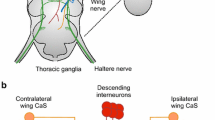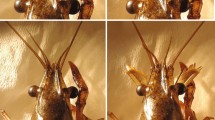Summary
The locust,Locusta migratoria (L.), performs tethered flight in the laminar flow of a wind tunnel. The animal is fixed ventrally to a stimulus device which produces rotations (max. rotation angle ± 15°) (Fig. 2). Depending upon the position of the axes relative to space and to the animal the latter is forced to rotate in the frontal, mediosagittal, or transversal plane. Simultaneous electromyograms from the direct downstroke muscles of the wings (7 electrodes implanted on each side in the following muscles, numbered after Snodgras: forewing 97, 98, 99, hindwing 127, 128, 129, in the last 2 electrodes) are made and analysed by means of a special data acquisition processor (Fig. 1) and digital computer.
One observes shifts in the time of occurrence (‘time shifts’) of the action potentials of muscles belonging to the same wing and to different wings. For example: A 20° rotation is correlated with a time shift of up to 6 ms between the muscles 971 and 991 (left forewing) and between 991 and 1271 (different wings) (Fig. 8b).
On rotating the animal to the left within the frontal plane (yaw) (Figs. 7, 8), the left side muscles 971, 981, 1271, and 1281 fire earlier and the muscles 991 and 1291+2, 1 fire later than during straight ahead flight whilst on the right side the muscles 97r, 98r, 127r, and 128r fire later and 99r and 1291+2, r fire earlier.
On rotation within the mediosagittal plane (pitch) (Fig. 9), the muscles 97, 98, and 1291+2 on both sides fire earlier when the head is raised, whereas 99 fires later. No definite statement can be made about the behaviour of the remaining downstroke muscles.
On rotation towards the right within the transversal plane (roll) (Fig. 10), the downstroke muscles of the left forewing fire earlier whereas those on the right fire later. No general scheme can be derived for both hindwing downstroke muscles.
Thus the behaviour of the direct downstroke muscles is essentially symmetrical to the position of the axes of rotation as far as the time shifts are concerned (Fig. 11).
In general (despite certain exceptions, see Fig. 12), the time shift curves vary so greatly that no definite coupling between different muscles should be assumed.
Similar content being viewed by others
References
Altman, J.S., Tyrer, N.M.: The locust wing hinge stretch receptor. J. comp. Neurol. (in press)
Burrows, M.: Monosynaptic connexions between wing stretch receptors and flight motorneurones of the locust. J. exp. Biol.62, 189–219 (1975)
Dubs, F.: Aerodynamik der reinen Unterschallströmung. Basel: Birkhäuser 1966
Dugard, J.J.: Directional change in flying locusts. J. Insect Physiol.13, 1055–1963 (1967)
Elsner, N.: Neuroethology of sound production in gomphocerine grasshoppers (Orthoptera: Acrididae). II. Neuromuscular activity underlying stridulation. J. comp. Physiol.97, 291–322 (1975)
Gettrup, E.: Sensory regulation of wing twisting in locusts. J. exp. Biol.44, 1–6 (1966)
Nachtigall, W.: Getrennte Systeme im Fliegenthorax für die Erzeugung und Verteilung aerodynamischer Kräfte. Naturwissenschaften54, 323 (1967)
Nachtigall, W.: Wie steuern die Insekten während des Fluges? Umschau69, 554 (1969)
Möhl, B., Zarnack, W.: Flugsteuerung der Wanderheuschrecke durch Verschiebung der Muskelaktivität. Naturwissenschaften62, 441 (1975)
Möhl, B., Zarnack, W.: Activity of the direct downstroke flight muscles ofLocusta migratoria (L.) during steering behaviour in flight. II. Dynamics of time shift and changes in burst length. J. comp. Physiol.118, 235–247 (1977)
Pfau, H.K.: Zur Morphologie und Funktion des Vorderflügels und Vorderflügelgelenks vonLocusta migratoria L. Fortschr. Zool. (in press)
Tyrer, N.M., Altman, J.S.: Motor and sensory flight neurones in a locust demonstrated using cobalt chloride. J. comp. Neurol.157, 117–138 (1975)
Waldron, I.: Neural mechanism by which controlling inputs influence motor output in the flying locust. J. exp. Biol.47, 213–228 (1967)
Weis-Fogh, T.: Notes on sensory mechanisms in locust flight. Phil. Trans. B239, 553–584 (1956)
Wendler, G.: The influence of proprioceptive feedback on locust flight co-ordination. J. comp. Physiol.88, 173–200 (1974)
Wilson, D.M.: Inherent asymmetry and reflex modulation of the locust flight motor pattern. J. exp. Biol.48, 631–641 (1968)
Wilson, D.M.: The nervous control of insect flight and related behaviour. Advanc. Insect Physiol.5, 289–338 (1968)
Wilson, D.M., Gettrup, E.: A stretch reflex controlling wingbeat frequency in grasshoppers. J. exp. Biol.40, 171–185 (1963)
Wilson, D.M., Weis-Fogh, T.: Patterned activity of co-ordinated motor units studied in flying locusts. J. exp. Biol.39, 643–667 (1962)
Zarnack, W.: Kinematik der Flügelschlagbewegung beiLocusta migratoria L. Dissertation, München (1969)
Zarnack, W.: Flugbiophysik der Wanderheuschrecke (Locusta migratoria L.). I. Die Bewegungen der Vorderflügel. J. comp. Physiol.78, 356–395 (1972)
Author information
Authors and Affiliations
Additional information
We wish to thank Prof. W. Nachtigall, Drs. H.K. Pfau and U. Koch for helpful discussions and critical reading of the manuscript, also Frau W. Jenal for technical assistance and help with the English translation. Helpful comments were received from Prof. G. Wendler. Special thanks are due to Drs. J.S. Altman and N.M. Tyrer and Prof. F. Huber for their extensive and valuable criticism of the manuscript. The work is supported by a grant from the Stiftung Volkswagenwerk to Prof. W. Nachtigall.
Rights and permissions
About this article
Cite this article
Zarnack, W., Möhl, B. Activity of the direct downstroke flight muscles ofLocusta migratoria (L.) during steering behaviour in flight. J. Comp. Physiol. 118, 215–233 (1977). https://doi.org/10.1007/BF00611824
Received:
Issue Date:
DOI: https://doi.org/10.1007/BF00611824




